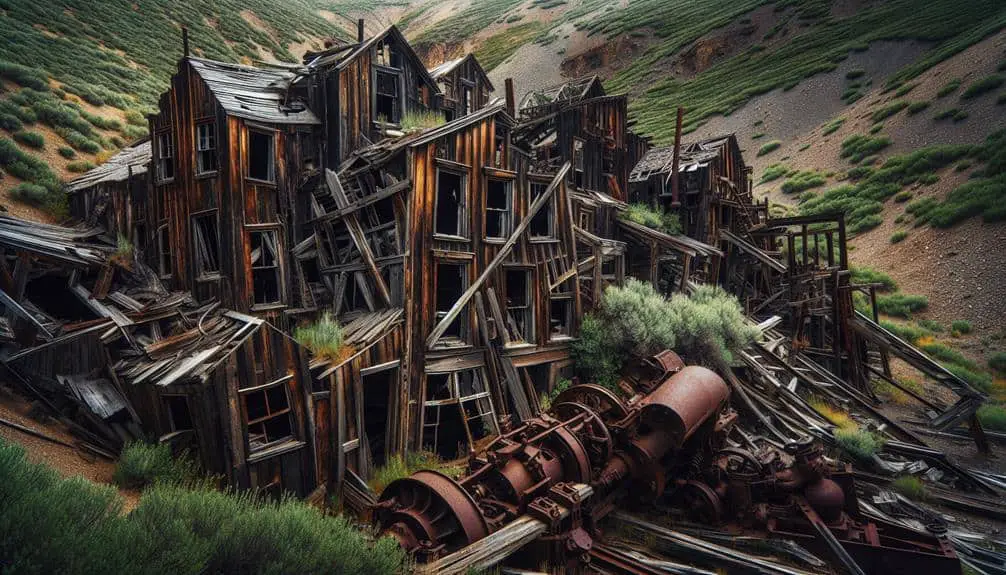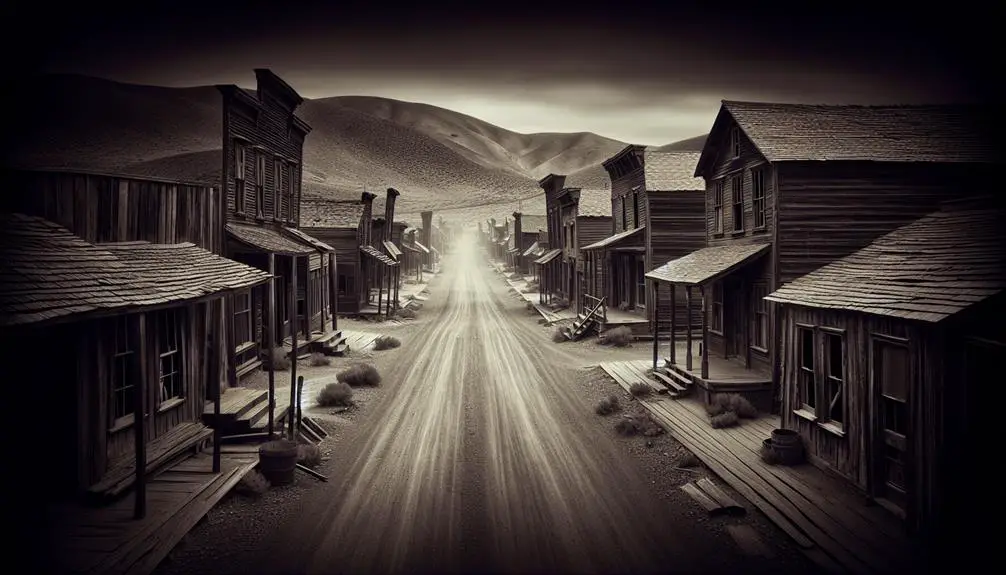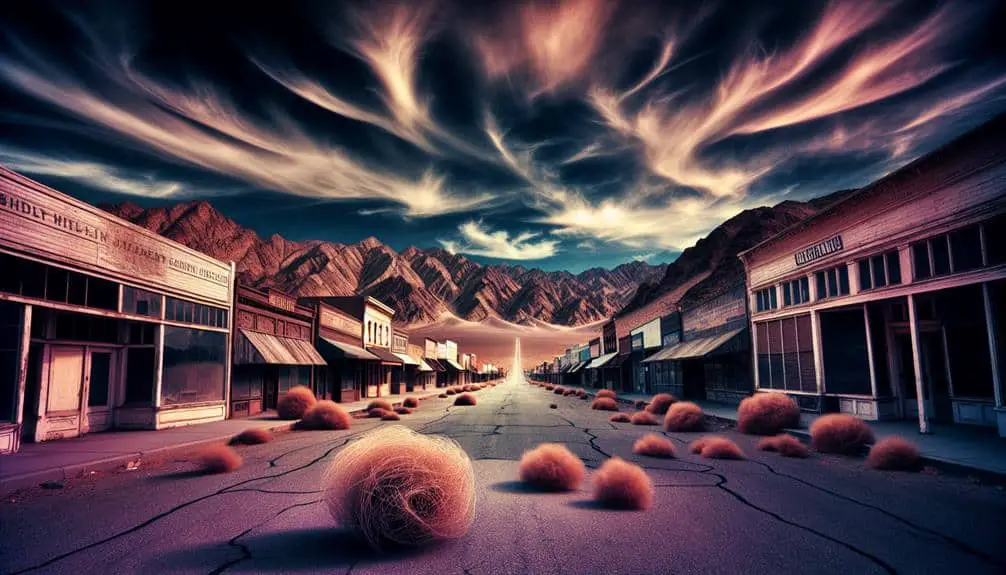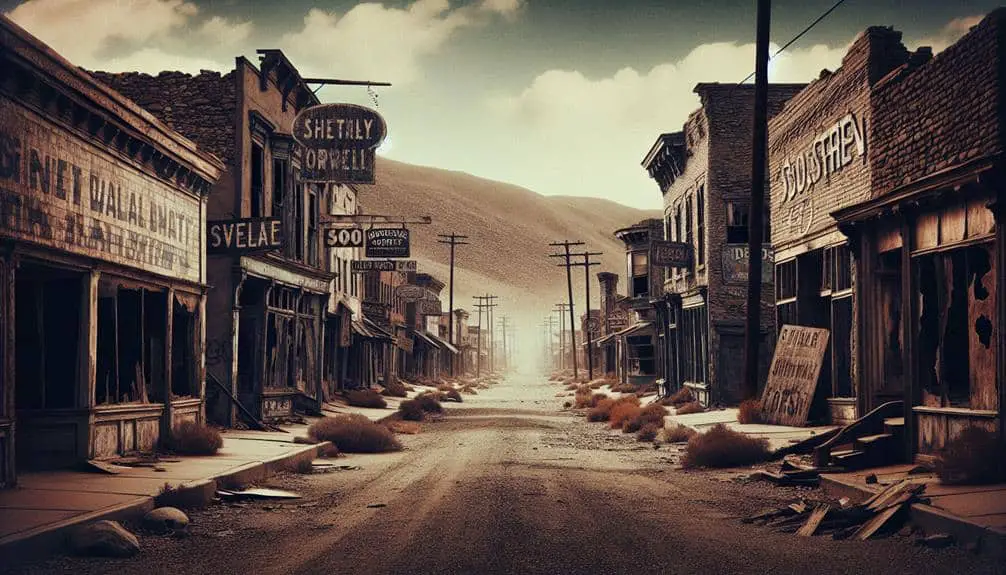Discover hauntingly beautiful forgotten mining towns in the Western US like Goldfield, Nevada, once a bustling hub in the desert with luxurious hotels. Bodie, California, in the Eastern Sierra region, showcases the stark boom-and-bust cycle. Silver City, Idaho, nestled in the Owyhee Mountains, echoes its 1860s origins with original buildings still standing. St. Elmo, Colorado, offers eerie tales with reported paranormal activity among abandoned buildings against a mountain backdrop. Rhyolite, Nevada, founded in 1905 after gold discovery, paints a picture of rapid decline by 1910, preserved in the Rhyolite Historic Area. Explore these towns for a glimpse into the past.
Key Points
- Goldfield, Nevada: Founded in 1902 with luxurious hotels, now a ghost town in the desert, reminding of boom-and-bust cycles.
- Bodie, California: Preserved Eastern Sierra town showcasing boom-and-bust cycles, offering a haunting glimpse into the past.
- Silver City, Idaho: Established in the 1860s, echoes the boom-and-bust narrative with many original buildings still standing.
- St. Elmo, Colorado: Abandoned town with eerie beauty and reported paranormal activity, frozen in time against a mountain backdrop.
- Rhyolite, Nevada: Founded in 1905 after gold discovery, now a preserved area with abandoned buildings offering a glimpse into the past.
Goldfield, Nevada
Goldfield, Nevada, a once-thriving mining town in the early 20th century, now stands as a demonstration of the rise and fall of the mining industry in the Western US. This ghost town, nestled in the desert landscape, serves as a poignant reminder of the boom-and-bust cycles that characterized many mining communities of the time. Founded in 1902, Goldfield quickly grew into a bustling hub fueled by gold and silver mining. The town boasted luxurious hotels, saloons, and a population that rivaled larger cities. However, as the mines began to deplete, Goldfield's fortune waned, leading to its eventual decline.
The mining history of Goldfield reflects the broader narrative of the American West, where dreams of prosperity often collided with the harsh realities of extractive industries. The remnants of Goldfield's once-thriving community now offer visitors a glimpse into the challenges faced by these towns, highlighting the transient nature of mining booms. As you wander through the empty streets and dilapidated buildings, you can't help but ponder the legacy of Goldfield and the individuals who sought their fortunes in this unforgiving land.
Bodie, California
Nestled in the rugged landscape of California's Eastern Sierra region, Bodie stands as a stark evidence of the boom-and-bust cycle that defined many mining towns in the American West. Once a bustling gold mining town in the late 1800s, Bodie quickly declined as the gold veins ran dry, eventually earning the title of a ghost town.
Despite its abandonment, Bodie's remarkable state of preservation sets it apart. The town's ghostly appearance, with its weathered buildings frozen in time, offers a haunting glimpse into the past. Efforts in historical conservation have ensured that Bodie remains in a state of 'arrested decay,' maintaining its authenticity while safeguarding it from further deterioration.
Visiting Bodie today allows you to wander through the empty streets, peering into the past through the windows of abandoned homes and businesses. The eeriness of the ghost town coupled with the dedication to historical conservation creates a unique experience, offering a window into the challenges and triumphs of the Wild West's mining communities.
Silver City, Idaho
In the rugged terrain of Idaho's Owyhee Mountains lies Silver City, a once-thriving mining town that echoes the boom-and-bust narrative seen in Bodie, California. Founded in the 1860s following the discovery of silver ore, Silver City quickly grew into a bustling hub, boasting schools, saloons, and a newspaper. However, as the mines depleted, the town's population dwindled, eventually leading to its classification as a ghost town.
Despite its ghost town status, Silver City stands as a proof of the rich history of the American West. Efforts in historical conservation have made sure that many of the town's original buildings still stand, offering visitors a glimpse into the past. From the preserved schoolhouse to the weathered storefronts, each structure tells a story of the town's former glory.
Today, Silver City serves as a reminder of the transient nature of mining towns and the significance of historical preservation in capturing the essence of these once-thriving communities. Wander through its empty streets, and you'll feel the whispers of a bygone era, where hope and prosperity once thrived amidst the rugged Idaho landscape.
St. Elmo, Colorado
With a haunting ambiance that lingers in the crisp mountain air, St. Elmo, Colorado, stands as proof of the resilience of Western mining towns. The town, now mostly deserted, presents a mix of eerie beauty and historical intrigue that captivates visitors.
- Abandoned Buildings: Dilapidated structures line the dusty streets, whispering tales of bygone eras and forgotten lives.
- Paranormal Activity: Locals and visitors alike have reported strange occurrences, from ghostly apparitions to unexplained sounds echoing through the empty buildings.
- Mountain Backdrop: Towering peaks frame the town, casting shadows that dance along the deserted storefronts and crumbling facades.
- Time Capsule: St. Elmo feels frozen in time, offering a glimpse into the past with each weathered building and rusted relic.
Exploring St. Elmo is like stepping into a ghostly Western film set, where the spirits of miners and pioneers seem to linger among the abandoned remnants of a once-thriving community.
Rhyolite, Nevada
The desolate landscape of Rhyolite, Nevada, serves as a stark reminder of the transient nature of boomtowns in the Western US. Founded in 1905 after a significant gold discovery, Rhyolite quickly grew to a population of over 5,000 residents. The town boasted modern amenities including electric lights, water mains, newspapers, and a three-story bank building. However, by 1910, the ore began to deplete, leading to a rapid decline in population as residents sought opportunities elsewhere.
Today, Rhyolite stands as a ghost town, with abandoned buildings like the Cook Bank Building and the Bottle House offering a glimpse into its past. The town's history is preserved by the Rhyolite Historic Area, attracting visitors interested in exploring the remnants of this once-thriving community. The stark contrast between Rhyolite's former glory and its current state serves as a poignant reflection on the ephemeral nature of mining towns in the American West.
Frequently Asked Questions
How Did the Towns Get Their Names?
When investigating the etymology of town names, delve into their history and origins. Uncover the stories behind how these towns got their names, revealing a rich tapestry of culture, heritage, and the passage of time.
What Was the Primary Industry in These Towns Before They Became Abandoned?
Before economic decline hit, the primary industry in these towns was mining. This industry was central to their growth and prosperity. However, as resources dwindled and competition increased, many abandoned mines led to their downfall.
Are There Any Ghost Stories or Legends Associated With These Towns?
Ghost stories and legends abound in these abandoned towns. Haunted tales of spectral miners, supernatural encounters in empty saloons, and mysterious happenings have spurred paranormal investigations. Explore the eerie remnants and uncover the chilling past.
What Efforts Have Been Made to Preserve or Restore Any of the Buildings in These Towns?
To preserve and restore buildings in forgotten mining towns, historical preservation societies conduct surveys to identify structures at risk. Architectural restoration efforts involve stabilizing foundations, repairing facades, and documenting original features for authenticity.
Have Any Famous or Notable Individuals Lived in These Towns During Their Heyday?
Notable residents and famous figures often graced these towns during their prime. From entrepreneurs to outlaws, these settlements attracted a diverse crowd, leaving behind stories of prosperity, hardship, and intrigue for modern explorers.



